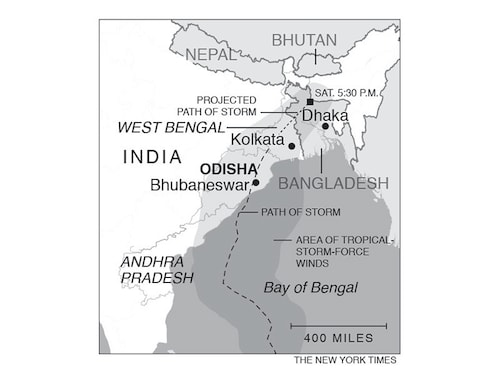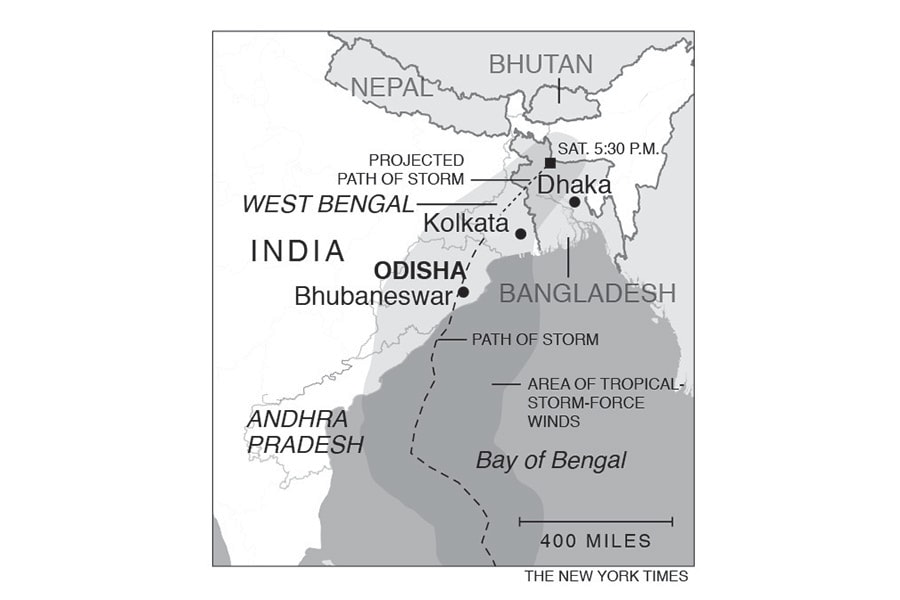How do you save 1 million people from a cyclone? Lessons from one of India's poo
Odisha created an example of sorts for the world showing excellent disaster management skills


 The path of Cyclone Fani in India and BangladeshBHUBANESWAR, India — Flights were canceled.
The path of Cyclone Fani in India and BangladeshBHUBANESWAR, India — Flights were canceled.
Train service was out.
And one of the biggest storms in years was bearing down on Odisha, one of India’s poorest states, where millions of people live cheek by jowl in a low-lying coastal area in mud-and-stick shacks.
But government authorities in Odisha, along India’s eastern flank, hardly stood still. To warn people of what was coming, they deployed everything they had: 2.6 million text messages, 43,000 volunteers, nearly 1,000 emergency workers, television commercials, coastal sirens, buses, police officers, and public address systems blaring the same message on a loop, in local language, in very clear terms: “A cyclone is coming. Get to the shelters.”
It seems to have largely worked. Cyclone Fani slammed into Odisha on Friday morning with the force of a major hurricane, packing 120 mph winds. Trees were ripped from the ground and many coastal shacks smashed. It could have been catastrophic.
But as of early Saturday, mass casualties seemed to have been averted. While the full extent of the destruction remained unclear, only a few deaths had been reported, in what appeared to be an early-warning success story.
The most vulnerable people, it seemed, had gotten out of the way.
Experts say this is a remarkable achievement, especially in a poor state in a developing country, the product of a meticulous evacuation plan in which the authorities, sobered by past tragedies, moved 1 million people to safety, really fast.
“Few would have expected this kind of organizational efficiency,” said Abhijit Singh, a former naval officer and head of the Maritime Policy Initiative at the Observer Research Foundation, a research organization. “It is a major success.”
The storm also hit neighboring Bangladesh, but there, too, large numbers of casualties were avoided by evacuating more than 1 million people to shelters.
This is so different from 20 years ago, when a fearsome cyclone blasted into this same area and obliterated villages, killing thousands. Many people were caught flat-footed in their homes. Some of the dead were found miles from where they had lived, dragged away by raging cascades.
After that, the Odisha authorities vowed to ensure a disaster like that never felled them again.
“We have a very serious commitment on this — there should not be any loss of life,” said Bishnupada Sethi, the state’s special relief commissioner, who has been supervising the operation. “This is not the work of a day or a month but of 20 years.”
One of the first steps taken after the 1999 disaster was the construction of hundreds of cyclone shelters up and down the coast. The shelters were built up to a few miles from the shore.
They aren’t picturesque — picture a bare, two-story, peeling paint cement block rectangular building on stilts, almost resembling a crab. But the structures, designed by the faculty at one of India’s elite universities, Indian Institute of Technology Kharagpur, have proved storm-worthy.
Over the past week, even when Fani was hundreds of miles away, Indian authorities had been closely watching. They had first picked up a large swirl on meteorological radar screens barreling up from the equator, deep in the ocean between Sri Lanka and Indonesia.
It was not yet a cyclone, but rather what meteorologists call a deep depression — a spiraling low-pressure storm that sucks in warm air. As it moves across warm waters, like those in the Bay of Bengal, the storm strengthens.
By midweek, Fani had become a cyclone. Meteorologists accurately predicted its path. For days, they had been saying it would head straight up the Bay of Bengal and make landfall in Odisha.
The state of Odisha has around 46 million people, about the population of Spain, but many times poorer. The average income is less than $5 a day. The majority of people are farmers.
Along the coast, many men work on wooden fishing boats. As Fani approached, the boats were ordered ashore.
On Thursday morning, Odisha government officials released a five-page plan. They seemed to have left nothing uncovered. The most important part was to get people to the shelters. Since Odisha has been hit by many killer storms, state emergency officers said, they had drilled on their evacuation plans many times.
All emergency personnel were ordered to district operation centers. Government workers drafted lists of people in vulnerable houses, particularly the elderly and children.
Tourists at coastal hotels were advised to leave, and an enormous amount of equipment was readied to deal with the storm’s aftermath, including 300 power boats, two helicopters and many chain saws, to cut downed trees.
At the same time, truckloads of food and bottled water were delivered to the shelters.
As the sea turned frothy Thursday afternoon and the rain began to fall, the loudspeakers blared messages telling people to go to the nearest shelter as soon as possible.
In some areas, there was no choice. Police officers escorted the emergency workers who moved through the coastal towns, exhorting people to leave. Packed buses chugged up and down the roads around Puri, a coastal town that was predicted to get walloped. Each shelter could hold several hundred people. They quickly filled.
“We moved here because it is safe,” said Sabakali Mason, a man in his 50s who waited inside a shelter with his wife. “Our house may collapse.”
By Thursday night, most shelters were bustling concentrations of humanity, full of men, women and slightly dazed children. Some people had walked there others had been scooped up by the free government buses. Families sat on the floors, eating together, listening to Fani’s winds pick up speed.
Around 9 a.m. Friday, Fani screamed ashore, the eye passing near Puri, as predicted. In Bhubaneswar, Odisha’s state capital, about 40 miles north, huge tree limbs snapped in the lashing rain. No one ventured outside.
In Puri, the winds wrecked just about all the roadside kiosks. Officials said the gusts reached at least 100 mph. They will never know, they said, because the gusts knocked down the machine that measures the wind.
The Odisha authorities said more than 100 people were injured. Indian news media reported several people had died, including some killed by flying debris.
Many people, even if they hadn’t lost their lives, lost their livelihoods.
“Nature punishes the poor people more and spares the rich,” said S.K. Behra, the owner of a smashed tea stall in Bhubaneswar. “What can I do? I am helpless. Slowly I will rebuild my life again.”
But as the storm weakened and the worst seemed over, there was little doubt that the high level of preparedness had saved lives.
“The government is usually dysfunctional in cases like this but the whole mobilization was quite impressive,” said Singh, the former naval officer. “Evacuating a million people in three or four days and providing them with not just shelter but also food is a big achievement in such a short time.”
Krishan Kumar, an officer in the Khordha district of the Odisha government, said the government’s success reflected an accumulated wisdom.
“Every small cyclone or tsunami teaches you how to deal with the bigger ones,” he said. “If you don’t learn from the past experiences, you will drown.”
First Published: May 06, 2019, 14:57
Subscribe Now